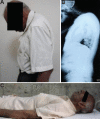Assessment of striatal & postural deformities in patients with Parkinson's disease
- PMID: 28361820
- PMCID: PMC5393078
- DOI: 10.4103/ijmr.IJMR_502_15
Assessment of striatal & postural deformities in patients with Parkinson's disease
Abstract
Background & objectives: Though striatal and postural deformities are known to occur commonly in atypical Parkinsonism patients, these may also be seen in patients with Parkinson's disease (PD). These are frequently misdiagnosed as joint or orthopaedic pathology leading to unnecessary investigations. This study was conducted to observe the various striatal and postural deformities among patients with PD in India.
Methods: This study was conducted at a tertiary care teaching institute in north# India. Seventy consecutive patients with PD diagnosed as per the modified UK Brain Bank criteria were included. Various striatal (hand & foot) and postural (antecollis, camptocormia, scoliosis & Pisa syndrome) deformities and their relation with the duration of disease, severity [measured by the Unified Parkinson's Disease Rating Scale (UPDRS)] and levodopa intake were analyzed.
Results: Of the 70 patients with PD, 34 (48.57%) had either striatal or postural deformities. Striatal foot was the most common deformity observed (25.71%). Camptocormia was the second most common deformity (20%). Striatal and postural deformities were seen in more advanced PD as suggested by significantly higher UPDRS and Hoehn and Yahr scale (P<0.001). Striatal deformities were more ipsilateral to PD symptom onset side (agreement 94.44%). Pisa and scoliosis concavity were more on contralateral side to PD symptoms onset side (66.67%).
Interpretation & conclusions: Our results showed that striatal and postural deformities were common and present in about half of the patients with PD. These deformities we more common in patients with advanced stage of PD.
Conflict of interest statement
Figures





Comment in
-
Understanding of skeletal deformities in Parkinson's disease.Indian J Med Res. 2016 Nov;144(5):650-652. doi: 10.4103/ijmr.IJMR_1166_16. Indian J Med Res. 2016. PMID: 28361815 Free PMC article. No abstract available.
References
-
- Ashour R, Jankovic J. Joint and skeletal deformities in Parkinson's disease, multiple system atrophy, and progressive supranuclear palsy. Mov Disord. 2006;21:1856–63. - PubMed
-
- Ashour R, Tintner R, Jankovic J. Striatal deformities of the hand and foot in Parkinson's disease. Lancet Neurol. 2005;4:423–31. - PubMed
-
- Jankovic J. Parkinson's disease: clinical features and diagnosis. J Neurol Neurosurg Psychiatry. 2008;79:368–76. - PubMed
-
- Melamed E, Djaldetti R. Camptocormia in Parkinson's disease. J Neurol. 2006;253(Suppl 7):VII14–16. - PubMed
MeSH terms
Substances
Supplementary concepts
LinkOut - more resources
Full Text Sources
Other Literature Sources
Medical
